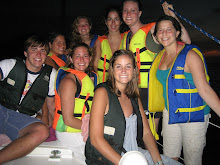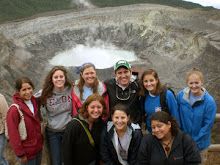On the weekend of November 3, our biology class headed to the Talamanca Mountain Range along with Alejandra, our professor, and two teaching assistants. The weekend started with a two hour drive to an oak forest, which we hiked through, eventually reaching a remote mountain bog. The topography of these two areas was COMPLETELY different than what we have seen thus far in Costa Rica. The trees in the oak forest were shorter, the canopy was less dense, and moss and vines hung everywhere. The bog was - in a word- muddy. I made one wrong stepped and was sucked into mud nearly as deep as my stomach! It was cold, and I am pretty sure I felt creepy crawlies slithering around my legs. Luckily, Amanda came to my rescue, grabbed me around my shoulders and pulled me out. Still, I had to hike around in wet jeans and water-filled boots for another hour. It was miserable!
After a quick lunch near the oak forest, we continued our drive to La Georgina Hotel and Restaurant in Cerro de la Muerte, where we would be staying for the night. We drove all this way in order to study hummingbirds, and La Georgina was selected because of the abundance of hummingbirds attracted to the restaurant's sugar-water feeders. We went for another hike (in the pouring rain, not so fun).
Cerro de la Muerte basically translates into "Mountain of Death" because in the olden days, people who camped in the area were at risk of dying of hypothermia or other perrils of cold weather. The thermometer said it was about 40 degrees but it was raining, and after two months of living in a hot and humid tropical climate, we were all miserable. I literally wore 5 long sleeve shirts, one North Face jacket, two pairs of pajama pants, and three pairs of socks to bed, and I was STILL cold. Future ENS students should definitely pack accordingly, and be aware that La Georgina is by no means a deluxe hotel (there are no heaters or hot showers).
Sunday started for us bright and early at 5:45 am. Basically, we set up nets to catch hummingbirds who were eating at the sugarwater feeders and then checked for pollen on their bodies. The hypothesis was that feeders negatively impact growth of local flowers, because the birds who eat from the feeders aren't fulfilling their roles as pollinators. The only thing that made the experiment worthwhile was holding these tiny little birds in our hands. They're soo fragile, and it's hard to believe that their rainbow colored, irridescent feathers are natural. They were just so beautiful!
In the early afternoon, we packed up and headed back to San Jose to later evaluate the data we collected over the weekend. While the trip wasn't the most fun way to spend a weekend, holding the hummingbirds was definitely a worthwhile once-in-a-lifetime experience :)
by Jessi
Tuesday, November 13, 2007
Subscribe to:
Post Comments (Atom)



.jpg)

No comments:
Post a Comment